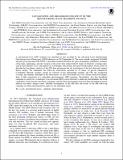LOCALIZATION AND BROADBAND FOLLOW-UP OF THE GRAVITATIONAL-WAVE TRANSIENT GW150914
Author(s)
Aggarwal, Nancy; Barsotti, Lisa; Biscans, Sebastien; Bodiya, Timothy P.; Brown, N. M.; Buikema, Aaron; Donovan, Frederick J; Essick, Reed Clasey; Evans, Matthew J; Fritschel, Peter K; Gras, Slawomir; Isogai, Tomoki; Katsavounidis, Erotokritos; Kontos, Antonios; Libson, Adam A.; Lynch, Ryan Christopher; MacInnis, Myron E; Mason, Kenneth R; Matichard, Fabrice; Miller, John; Mittleman, Richard K; Ray Pitambar Mohapatra, Satyanarayan; Oelker, Eric Glenn; Shoemaker, David H; Tse, Maggie; Vaulin, Ruslan; Vitale, Salvatore; Weiss, Rainer; Yam, William; Yu, H.; Zhang, Fan; Zucker, Michael E; ... Show more Show less
DownloadAbbott_2016_ApJL_826_L13.pdf (3.252Mb)
PUBLISHER_POLICY
Publisher Policy
Article is made available in accordance with the publisher's policy and may be subject to US copyright law. Please refer to the publisher's site for terms of use.
Terms of use
Metadata
Show full item recordAbstract
A gravitational-wave (GW) transient was identified in data recorded by the Advanced Laser Interferometer Gravitational-wave Observatory (LIGO) detectors on 2015 September 14. The event, initially designated G184098 and later given the name GW150914, is described in detail elsewhere. By prior arrangement, preliminary estimates of the time, significance, and sky location of the event were shared with 63 teams of observers covering radio, optical, near-infrared, X-ray, and gamma-ray wavelengths with ground- and space-based facilities. In this Letter we describe the low-latency analysis of the GW data and present the sky localization of the first observed compact binary merger. We summarize the follow-up observations reported by 25 teams via private Gamma-ray Coordinates Network circulars, giving an overview of the participating facilities, the GW sky localization coverage, the timeline, and depth of the observations. As this event turned out to be a binary black hole merger, there is little expectation of a detectable electromagnetic (EM) signature. Nevertheless, this first broadband campaign to search for a counterpart of an Advanced LIGO source represents a milestone and highlights the broad capabilities of the transient astronomy community and the observing strategies that have been developed to pursue neutron star binary merger events. Detailed investigations of the EM data and results of the EM follow-up campaign are being disseminated in papers by the individual teams. Keywords: gravitational waves, methods: observational
Date issued
2016-07Department
MIT Kavli Institute for Astrophysics and Space ResearchJournal
The Astrophysical Journal
Publisher
American Astronomical Society
Citation
Abbott, B. P., et al. “LOCALIZATION AND BROADBAND FOLLOW-UP OF THE GRAVITATIONAL-WAVE TRANSIENT GW150914.” The Astrophysical Journal, vol. 826, no. 1, July 2016, p. L13. © 2016 The American Astronomical Society
Version: Final published version
ISSN
2041-8213